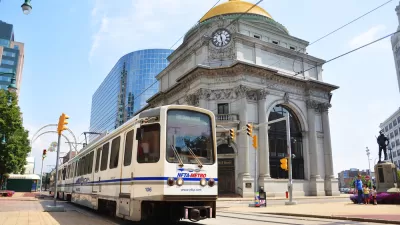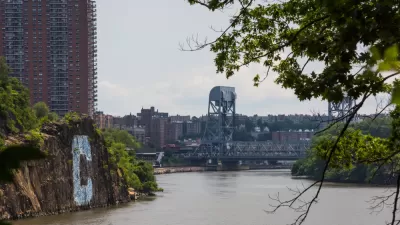A plan to revitalize Buffalo's Outer Harbor as an expansive, fully programmed park was sunk by a housing component. A new draft is expected soon.
Mark Sommer reports on the process of planning a new future for Buffalo's Outer Harbor. A previous planning process for the "526 acres of nature on a windy Lake Erie" culminated in September 2014 as a vision of pedestrian and bike paths, hiking trails, shoreline enhancements, boat launches, a gazebo, a playground, overlooks, and amphitheater, and a waterfront promenade, among other amenities and facilities.
But, Sommer reports, "adding housing and cultural development – the icing on the cake to some waterfront planners – proved to be a flash point. Opposition from the public and key lawmakers forced the plan back to the drawing board."
The proposal called for three clusters of housing, totaling between 1,500 and 2,100 units, which would help pay for the park that would make up most of the area. "But the idea of dense housing on the Outer Harbor scored poorly with the hundreds of people who participated in planning exercises," reports Sommer. "That included opposition to housing planned on land east of Times Beach, from where the Queen City Bike Ferry now arrives and departs, and Wilkeson Pointe. The waterfront agency said a study showed the preserve wouldn’t be harmed. Environmentalists disagreed."
The rest of the article goes on to examine other models that might influence the next draft of the plan, including the improvements made at the Milwaukee waterfront as well as standards set by the Green Code, expected for adoption by the Buffalo Common Council later this year.
FULL STORY: Outer Harbor popularity places spotlight on housing

Maui's Vacation Rental Debate Turns Ugly
Verbal attacks, misinformation campaigns and fistfights plague a high-stakes debate to convert thousands of vacation rentals into long-term housing.

Planetizen Federal Action Tracker
A weekly monitor of how Trump’s orders and actions are impacting planners and planning in America.

Chicago’s Ghost Rails
Just beneath the surface of the modern city lie the remnants of its expansive early 20th-century streetcar system.

Bend, Oregon Zoning Reforms Prioritize Small-Scale Housing
The city altered its zoning code to allow multi-family housing and eliminated parking mandates citywide.

Amtrak Cutting Jobs, Funding to High-Speed Rail
The agency plans to cut 10 percent of its workforce and has confirmed it will not fund new high-speed rail projects.

LA Denies Basic Services to Unhoused Residents
The city has repeatedly failed to respond to requests for trash pickup at encampment sites, and eliminated a program that provided mobile showers and toilets.
Urban Design for Planners 1: Software Tools
This six-course series explores essential urban design concepts using open source software and equips planners with the tools they need to participate fully in the urban design process.
Planning for Universal Design
Learn the tools for implementing Universal Design in planning regulations.
planning NEXT
Appalachian Highlands Housing Partners
Mpact (founded as Rail~Volution)
City of Camden Redevelopment Agency
City of Astoria
City of Portland
City of Laramie




























